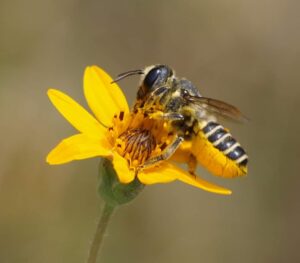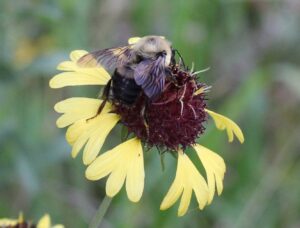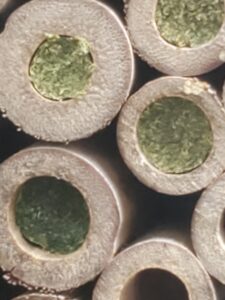
Megachile Bee photo courtesy of Carol Leonardi Clark
June 19th-25th, 2023 is National Pollinator Week. Travis County Master Gardener Vicki Blachman gives us a deep dive into native bees with this guest post.
A Short Intro to Native Bees by Vicki Blachman
There are over 20,000 bee species in the world. Of those, close to 4,500 are considered native to the U.S., and up to 1000, native to Texas. They have seven family classifications, of which six are right here in Texas1. Our native bees range in size from nearly an inch long down to smaller than a peppercorn2. I’ve tried to limit the scope of this article to the least I find I can say given that “the native bees of Texas” is a broad topic well suited to the size of our state.
The Importance of Native Bees
The iconic golden yellow and black striped honey maker, the honey bee (Apis mellifera spp.} is non-native but well established. As described by Michael Engle in 2009, it also appears to have at least one extinct ancestor (A. nearctica) that lived in North America 14 million years ago3. Our challenge is that those hairy-eyed honey bees in the Apis family get all the love and recognition while only recently have native bees been recognized for their intrinsic value to local biomes and as the workhorses they are. They need our help in getting the word out.
How many people even know native bees exist? The North American colonists imported European honey bees in the 1600’s. Prior to that, only native bees were pollinating every single flowering plant on this continent. Research shows that they are at least 3 times more effective as honey bees for pollination. Some pollinate plants honey bees can’t, or pollinate certain crops up to 20 times more effectively. Some like the bumble bee are capable of buzz pollination, or sonication, that honey bees lack. The takeaway? Our native bees have co-evolved over time with native plants to be mutually beneficial and mutually dependent – lose one and the other will be lost as well.
Native Bumble Bees Are Social
The terms “native” and “solitary” are often used interchangeably, but not all native bees are solitary, nor are all solitary bees native. A solitary bee queen will mate, deposit and provision her eggs, then continue laying eggs until her death 4 to 8 weeks after her own emergence. The eggs grow and pupate alone before emerging the following spring or early summer to repeat the cycle all over again4.

Carpenter Bee photo courtesy of Carol Leonardi Clark
By contrast, our native bumble bees are social or semi-social. Their nests have two generations at the same time. Honeybees are eusocial, or” true” social. They have multiple generations of individuals in the hive with each individual assigned a specific role to play in the collective.
Some solitary bees are non-native. The 1922 Honey Bee Importation law ended the imports of bees and bee products into the United States. This legislation applies only to honey bees. Importing non honey-producing solitary bees for research and subsequent commercial use2 continues. For example, hornfaced bees (Osmia cornifrons) were first imported from Japan to Utah in 1965, but did not survive. In 1976 a second importation into Maryland proved more successful. Thankfully they still thrive there since it’s a climate more like their home in central Japan. In recent years, the delightfully named shaggy fuzzyfoot bee (Anthophora pilipes villosula) from Japan is successfully pollinating for the commercial blueberry and other fruit industries.
Some solitary bees will form aggregations where nesting conditions are favorable. Even though a large number of individuals can occupy a site, they live there as individuals. Only a very few species are actually communal, meaning they actively help each other. Dependent on their environment, some members of the family Halictidae even have the unusual ability to switch between being social or solitary!7
Bee Nesting and Housing
The vast majority, up to 70%4, of North American native bees nest in the ground. Some make cells of mud, bits of leaves or petals, resin, hairy plant fibers, or wood dust. The cells are in underground tunnels that are generally more than a foot deep. Abandoned rodent burrows are a favorite spot. Ground nesting bees need unmulched, undisturbed soil for their nesting sites. The remaining 30% are cavity nesters, using hollow reeds, bamboo, logs, pithy stems, softwood structures, and even holes in bricks or other man-made items such as hand tools and equipment5.

Solitary bee nests plugged with bits of leaf.
Man-made bee houses may create teaching moments in the garden. Scatter the houses instead of clustering them together to avoid predation and reduce susceptibility to disease. Bee houses should have a guard of chicken wire, or other material with bee-sized holes, slightly out from and across the opening to prevent predation by birds. Nesting cavities should be at least 5” deep and closed at the back. Face the openings toward the morning sun, protect from rain, and insulate from extreme cold not placing inside to overwinter.6 Under the Texas Death Star, it can also be beneficial to have plants growing nearby that provide afternoon shade. Habitats should also include a source of moisture and shelter from wind. In the fall, leave stems for cavity nesters and grasses for shelter.
The native bees of Texas have co-evolved over time with Texas native flora to be mutually beneficial and mutually dependent. Once you realize their importance, you’ll never think of “bees” in quite the same way. Now I only need to tell you how important beetles are in pollination!
Additional Resources
Best Bee Friendly Plants for Austin
1http://w3.biosci.utexas.edu/jha/landowner-naturalist/texas-pollinator-guides
2https://www.usgs.gov/faqs/how-many-species-native-bees-are-united-states
3https://ucanr.edu/blogs/blogcore/postdetail.clm?postnum=1544&sharing=yes
4https://www.xerces.org/endangered-species/wild-bees
5https://www.xerces.org/blog/5-ways-to-increase-nesting-habitat-for-bees
7https://entnemdept.ufl.edu/creatures/misc/bees/halictid_bees.htm
https://www.fs.fed.us/wildflowers/pollinators/animals/bees.shtml
https://www.pollinator.org/pollinator-week
About Vicki Blachman
 Vicki has been a Texas A&M AgriLife Extension Service – Travis County Master Gardener volunteer since 2004. She holds the Texas Master Gardener Certified Specialist – Entomology title. She’s also recognized as a Habitat Steward and a Monarch Steward through the National Wildlife Federation. She is a co-chair of PollinATX, the working group behind the city of Austin being certified as a Bee City USA. Her home garden has been certified as a Monarch Waystation, a Certified Wildlife Habitat, a City of Austin Certified Butterfly Habitat, and a Best of Texas Wildlife Habitat.
Vicki has been a Texas A&M AgriLife Extension Service – Travis County Master Gardener volunteer since 2004. She holds the Texas Master Gardener Certified Specialist – Entomology title. She’s also recognized as a Habitat Steward and a Monarch Steward through the National Wildlife Federation. She is a co-chair of PollinATX, the working group behind the city of Austin being certified as a Bee City USA. Her home garden has been certified as a Monarch Waystation, a Certified Wildlife Habitat, a City of Austin Certified Butterfly Habitat, and a Best of Texas Wildlife Habitat.
